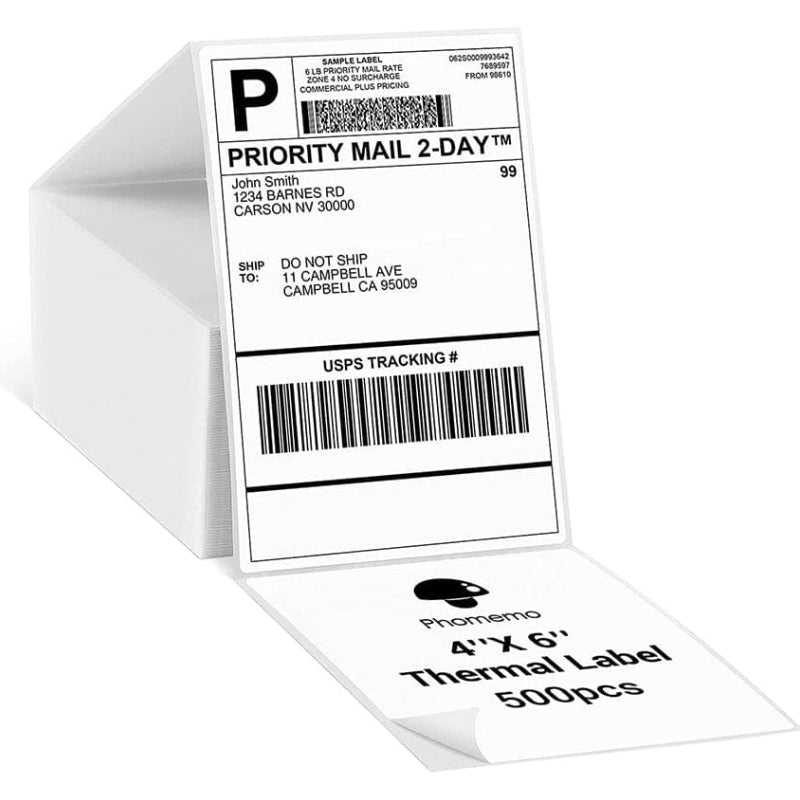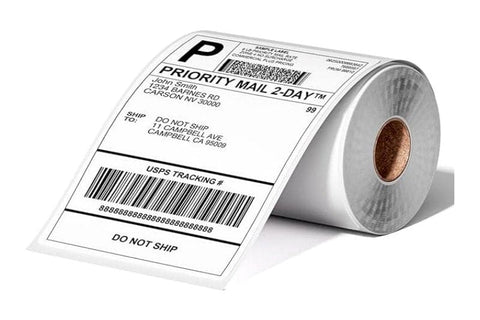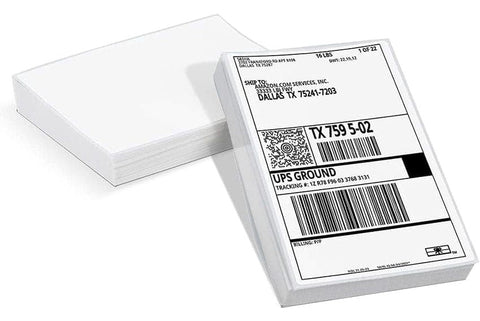- Understanding Shipping Label Size
- Choosing the Right Shipping Label Size
- Platform-Specific Recommendations
- Types of Shipping Labels
- Choosing the Best Shipping Label Printer
- Summary
4''x 6'' Fan-Fold Label
⭐ 231 Reviews
4''x 6'' Roll Label
⭐ 154 Reviews
If you are running a small business, ensuring your packages are accurately labeled is crucial for smooth shipping operations. However, with various shipping label sizes available in the market, it can be confused to determine which one suits your needs best. This article will walk you through everything you need to know about selecting the right size of shipping labels for your shipments.

Understanding Shipping Label Size
Before diving into specific dimensions, let's grasp the basics. Shipping labels come in various sizes to accommodate different package types and shipping requirements. The most common sizes include 4" x 6", 4" x 8.25", and 8.5" x 11".
Ideal for small to medium-sized packages, 4" x 6" shipping labels are widely used across multiple logistics and e-commerce platforms. They offer ample space for essential shipping information such as addresses, tracking numbers, and barcodes. Moreover, they are compatible with popular shipping label printers, making them a convenient choice for businesses of all sizes.
4" x 8.25" Shipping Label:
Slightly larger than the standard 4" x 6" shipping labels, the 4" x 8.25" size provides additional room for including extra details or larger fonts, which can be beneficial for enhancing visibility and readability. These labels are commonly used for bulkier packages or when more extensive shipping information needs to be displayed.
8.5" x 11" Shipping Label:
Often referred to as full-sheet labels, the 8.5" x 11" size is suitable for printing multiple shipping labels on a single sheet. While less common for individual package labeling, they are preferred for batch printing or when shipping documents and labels together. This size is compatible with standard printers, eliminating the need for specialized label printers.
Choosing the Right Shipping Label Size
When determining the appropriate size of shipping labels to purchase, consider factors such as package dimensions, shipping volume, and printing capabilities. For most standard shipments, 4" x 6" labels suffice, offering a balance between space efficiency and readability. However, if you frequently handle larger packages or require additional information on your labels, opting for larger sizes like 4" x 8.25" may be advantageous.
Platform-Specific Recommendations
Different logistics and e-commerce platforms may have their preferences regarding shipping label sizes. Here are some platform-specific recommendations commonly used in the United States:
- USPS (United States Postal Service): USPS typically recommends using 4" x 6" labels for their shipping labels, compatible with their Click-N-Ship service and other online postage providers.
- UPS (United Parcel Service): UPS supports various label sizes, including 4" x 6" and 4" x 8.25", depending on the shipping method and package size.
- FedEx: FedEx recommends using 4" x 6" labels for their shipments, compatible with FedEx Ship Manager and other online shipping tools.

Types of Shipping Labels
Given that the standard size for a shipping label is 4"x6", we recommend purchasing 4"x6" shipping labels. There are two main types of 4"x6" shipping labels: label roll and fan-fold label.
Shipping Label Roll
Advantages
- Space-saving: Shipping label roll can be easily stored in a printer, saving space in your workspace.
- Protection from Dust: Being inside the printer, shipping label rolls are protected from dust and other contaminants, ensuring label quality.
- Convenience: Shipping label rolls are convenient for continuous printing and application, reducing the need for frequent restocking.
Disadvantages
- Potential for Curling: However, one drawback is that roll labels may be prone to curling, especially if stored improperly or exposed to humidity.
Fan-fold Shipping Label
Advantages
- Continuous Printing: Fan-fold labels allow for continuous printing without the need for reloading, ideal for high-volume shipping operations.
- Minimal Dust Exposure: While fan-fold labels are exposed during printing, proper storage can minimize dust exposure.
- Less Frequent Restocking: Fan-fold labels typically come in larger stacks, reducing the frequency of restocking compared to rolls.
Disadvantages
- Potential for Sticking Together: One drawback is that fan-fold labels may stick together, requiring careful handling during printing.
Ultimately, the choice between shipping label roll and fan-fold shipping labels depends on your specific needs and preferences. If space-saving and dust protection are priorities, shipping label roll may be the preferred option. On the other hand, if continuous printing and less frequent restocking are more important, fan-fold labels might be the better choice. Consider factors such as printing volume, storage space, and environmental conditions when making your decision.
Choosing The Best Shipping Label Printer
The Phomemo Shipping Label Printer presents a budget-friendly option with impressive print speeds, making it an excellent choice for small to medium-sized businesses. Notably, it supports both roll and fan-fold labels, providing flexibility to accommodate diverse printing requirements.
The Shipping Label Printer exemplifies the printing technology: direct thermal. Renowned for its exceptional resolution and user-friendly setup, it's widely preferred for printing shipping labels.
Summary
Selecting the right shipping label size is essential for efficient and error-free shipping processes. By understanding your package requirements and considering platform-specific recommendations, you can streamline your labeling process and ensure your shipments reach their destinations promptly.
Now that you're equipped with the knowledge of shipping label size, you can confidently choose the perfect labels for your shipping needs.















